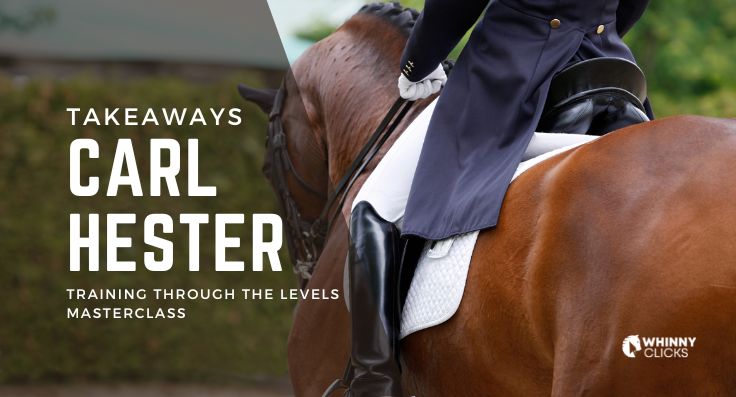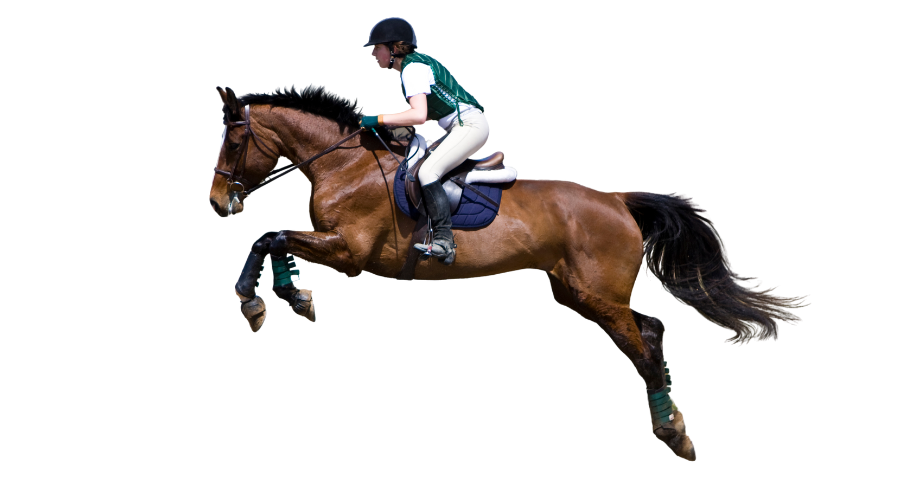Critical Takeaways from Carl Hester Masterclass: Training Through the Levels
Carl Hester recently conducted a masterclass at the World Equestrian Center (WEC) in Ocala. As someone who has read his books, I couldn’t have been more thankful to have the opportunity to attend this very special event. My only regret was not snagging a fan-girl photo with him when I noticed him hanging out before the class began!
For those of you who were unable to attend, I put together the key takeaways from each demonstration horse through the levels. No matter what level you are training or showing, there was something for everyone! Don’t forget to share these tips with a friend! Enjoy your next ride!
Flexion of the Horse
Carl mentioned that most horses he sees do not have enough right flexion going left OR right. Paying attention to right flexion is critically important since the majority of horses are more balanced going to the left. This makes the right contact and bend important in going both directions.
Rein Contact
Fingers should ALWAYS be closed on the reins, quiet, and in front of the saddle. If you need the horse to reach more forward and downwards, massage your fingers on the reins, but do not open the hand completely. The horse needs to have a consistent hand in order to be consistent.
You should give and retake the reins in front of the saddle all throughout the ride to make sure the horse stays nice and loose in the neck muscles (but keep fingers closed). This will also make the horse softer and encourage self-carriage of the head and neck.
Get Unlimited Featured Ads for Only $6.95
Perfect for selling 1 horse, or 20!
Advertise your horse on WhinnyClicks and start connecting with potential buyers today! With our user-friendly platform and helpful resources, selling your horse has never been easier. Sign up now and take the first step toward finding the right buyer for your equine companion.
$6.95 unlimited offer only available for a limited time
Many riders “bicycle” with the reins and let the outside shoulder fall out. To make sure you support the outside shoulder, “hold out with your outside rein and curve in with your inside rein” with your rein to keep the outside rein connected but get the bend to the inside. Carl calls this, “hold out, curve in.”
The role of the double bridle is the curb brings the horse down, and the snaffle brings the horse up.
For correct head and neck position at the Grand Prix, imagine balancing a glass of water in-between the horse’s ears to make the poll at the highest point.
Correct Aids
For the canter aid, Carl teaches all his horses to canter off of the outside leg aid. To do this, take your outside leg off of the horse and then put your outside leg on the horse slightly back. He mentioned that a lot of people teach their horse to canter off of the inside leg aid, but this is incorrect in his mind because a horse should do a flying change from moving the outside leg, not the inside leg aid.
In shoulder-in, many riders want to keep the outside leg off the horse. This is incorrect. To help the rider keep the outside leg supporting the horse, Carl recommends ensuring your outside toe faces letter A or letter C (depending on which direction you are riding on the long side).
Keeping your hand and leg aid separate is critical. If you push with your leg and hold with your hand simultaneously, you will just end up with a strong and stiff horse. If your horse is behind the leg, give rein and then touch with the leg.
With a lazy horse, you need a breathing leg, and with a hotter horse, you need to keep your leg angles closed, so they learn to accept the leg.
For the canter pirouette, think about turning the front first (position your hands in the direction of the movement), and then apply the leg.
Transitions
With horses of any level, lots of transitions are important. Some people think 10, 20, or 40 transitions are a lot, but Carl emphasized aiming for around 100 transitions between and within gaits. These transitions are what will improve the horse’s carriage, balance, and responsiveness to the rider.
Trot-to-canter is a pushing transition, and canter-to-trot is a swinging transition. These are great for young horses to develop strength.
Walk-to-canter and canter-to-walk will improve the balance in the canter.
Horses must always sit and collect in the canter before a walk transition.
Rider Position
Your upper body should be upright and stretching towards the ceiling with a strong core to help the horse slow down if going too quickly. On young horses, having your upper body a bit forward will help with upwards transitions.
For extensions, your upper body should come slightly forward, and your hand should come slightly forward to stay in balance with the horse and encourage the horse to seek contact.
The half halt is being able to brace your core in 1 stride and released immediately. If it lasts longer than one stride, then it is not a half halt.
You should sit on the horse to where you would land on your feet if the horse were removed from underneath you.
No stirrup work – Carl Hester and Charlotte Dujardin do no-stirrup work with their horses to ensure they keep a long leg and deep seat as riders. You can do this at trot and canter.
Rider fitness – Horses are athletes, and riders should be as well. Keeping strength up through exercise is important for riders as well as working on flexibility which will help with the rider’s seat.
In piaffe, the rider should sit over their knee and push from the seat in the passage.
Creating World-Class Gaits
Collected trot – The collected trot should NOT be slow. It should have a lot of expression and power (impulsion). Carl mentioned imagining the collected trot by thinking about having the expression and impulsion of a medium trot but uphill.
Medium and extended trot – To have a good medium and extended trot, you need to have a lot of expression and power in your collected trot first.
If a horse has naturally small paces, you need to make them go bigger. If a horse has naturally big paces, you need to make them smaller. If the horse naturally wants to bring its head and neck down and be heavy, then you need to ride them more upwards; if they want to carry their head and neck naturally higher, you need to ride them more downwards.
The forward and back exercise within the gaits brings expression into the gaits. When the horse goes forward, come back, and when the horse comes backward, go forwards. You can do this at trot and canter.
To get a strong horse lighter, a leg yield across the arena in canter is a great exercise to get the horse off of the rein. This isn’t in any dressage test, but it’s a valuable training exercise.
In the passage, it is important to bring it backward to create lift, and then when you go forward, make sure you do it slowly, in increments, to keep the power and lift (do not rush the horse forward).
If you are to have a top dressage horse, it needs to have the talent to BOTH push (passage and extended trot) and sit (piaffe and pirouette).
As the back of the horse gets shorter from collecting, the neck of the horse should get longer.
Improving the canter pirouette – On a 15m canter circle, ride travers to shoulder-in and back to travers and shoulder-in to improve adjustability. Pirouette should always start from a shoulder-in. The inside leg keeps the horse upright, and the outside leg is the accelerator. If you can’t canter on the spot, then you cant pirouette.
Accuracy of Movements
Every movement in a Dressage test should have a start, middle, and end. For example, in riding shoulder-in on the long side, the corner and start of the angle of the shoulder-in is the start of the movement. During the middle of the movement, everything needs to stay consistent, and at the end, the horse needs to go straight again.
Getting a good walk pirouette needs to start as a shoulder-in and end as a half-pass. For example, you can leg yield from the corner to the center line and then go into shoulder-in, do your walk pirouette, and immediately half pass out of it. This will help improve the canter pirouettes!
Know your strides – Know how many strides your horse takes to do every movement. The example Carl gave was understanding how many canter strides it takes your horse to canter 20 meters. If you need to do a flying change over the centerline, and you know it takes your horse 8 strides to canter 20 meters, then you know you will do a flying change on the 4th stride right on the centerline. This prevents you from looking around to see where the centerline letter is at.
If a horse gets crooked or swings in the flying changes, start schooling them on the arena’s wall. This will teach the horse to have straight flying changes.
The halt – anyone should be able to get good scores on the entrance, exit, and halt. To do this, teach your horse to stand square for everything! Every time you stop while riding, at the mounting block, and even when the horse is standing in cross-ties.
Carl’s Personal Routine
Carl’s personal horses follow a strict routine to keep them in top condition and happy in their work.
- For 10min – 15min, he takes all horses on a walk hack before the ride. This includes either walking in the paddock or down the road on a long rein to get them loose and walking with a purpose.
- For 10min – 15min, he then works them in the arena in a stretchy walk, trot, and canter with transitions to get them over the back and working.
- After that, he works on the tougher movements he plans to school that day.
- To conclude, he does 10min – 15min of a hack at a walk on a long-rein outside of the arena again to cool the horse down.
Conclusion
Carl Hester’s masterclass at the WEC was nothing short of spectacular! If you could not attend, I would highly recommend trying to snag a ticket to the next one. The wisdom is something that can be applied to most horses at any level. Don’t forget to share these dressage tips with a friend!



